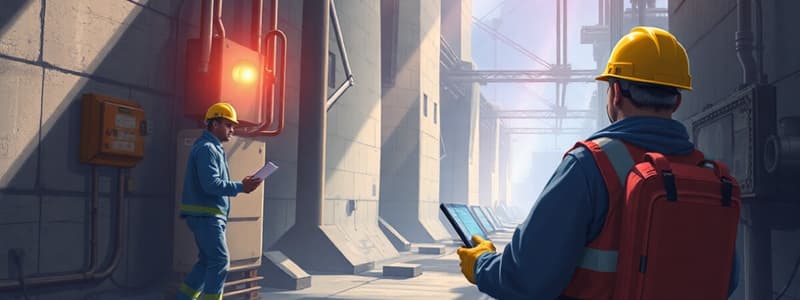Podcast
Questions and Answers
Which of the following is NOT a type of energy that must be controlled during energy isolation?
Which of the following is NOT a type of energy that must be controlled during energy isolation?
- Mechanical
- Electrical
- Thermal
- Chemical (correct)
What is the primary aim of a Permit to Work (PTW) system?
What is the primary aim of a Permit to Work (PTW) system?
- To increase the efficiency of work procedures
- To decrease the time taken for maintenance activities
- To ensure compliance with legal standards
- To prevent accidents by defining work scope and hazards (correct)
Who is responsible for ensuring compliance with PTW and energy control efforts?
Who is responsible for ensuring compliance with PTW and energy control efforts?
- Supervisors (correct)
- Environmental Officers
- Workers
- Authorized Personnel
What does the Lockout/Tagout (LOTO) process ensure?
What does the Lockout/Tagout (LOTO) process ensure?
Which best practice is essential for the efficiency of energy isolation measures?
Which best practice is essential for the efficiency of energy isolation measures?
What defines the role of authorized personnel in the PTW and LOTO processes?
What defines the role of authorized personnel in the PTW and LOTO processes?
What can be a consequence of non-compliance with the PTW system?
What can be a consequence of non-compliance with the PTW system?
Which component is NOT a part of a PTW system?
Which component is NOT a part of a PTW system?
Flashcards are hidden until you start studying
Study Notes
PTW (Permit to Work)
- A formalized system used to ensure safe execution of work in hazardous areas.
- Aims to prevent accidents by clearly defining work scope and hazards.
- Key components include:
- Risk Assessment: Evaluating risks associated with the job.
- Work Scope: Detailed description of tasks to be performed.
- Authorization: Issued by responsible personnel before work begins.
- Communication: Ensure all parties are informed about the work.
Energy Isolation
- A crucial step within PTW processes to prevent accidental release of energy.
- Involves isolating all forms of energy to protect workers during maintenance or repair activities.
- Types of energy that must be controlled:
- Electrical: Disconnect circuits, use locks/tagouts.
- Mechanical: Block moving parts, secure machinery.
- Hydraulic/Pneumatic: Bleed off pressure, lock valves.
- Thermal: Ensure systems are cooled or heated to safe levels.
Lockout/Tagout (LOTO)
- Procedure that ensures energy sources are properly isolated before work.
- Key elements include:
- Lockout: Physically preventing equipment from being operated.
- Tagout: Using tags to indicate equipment is not to be operated.
- Verification: Ensuring that the isolation has effectively removed energy.
Roles and Responsibilities
- Authorized Personnel: Individuals trained to implement PTW and LOTO processes.
- Workers: Must understand the PTW requirements and energy isolation procedures.
- Supervisors: Ensure compliance with PTW and oversee energy control efforts.
Best Practices
- Conduct thorough training for all personnel involved in energy isolation.
- Always follow documented procedures for PTW and energy isolation.
- Regularly review and update energy isolation practices.
- Conduct audits and inspections to ensure effective implementation.
Compliance and Safety
- Adhering to regulatory standards is essential for workplace safety.
- Non-compliance can lead to accidents, injuries, or fatalities.
- Maintain clear records of PTWs and energy isolation measures taken.
Permit to Work (PTW)
- A system used to ensure workplace safety during hazardous tasks.
### PTW Components
- Risk Assessment: Identifying potential hazards and risks.
- Work Scope: Clear description of the work involved.
- Authorization: Approved by responsible personnel before work begins.
- Communication: Ensures all parties are informed of the work.
### Energy Isolation
- A crucial step within PTW to prevent accidental release of energy.
### Energy Isolation Types
- Electrical: Disconnecting circuits and using locks/tagouts.
- Mechanical: Blocking moving parts and securing machinery.
- Hydraulic/Pneumatic: Bleeding off pressure and locking valves.
- Thermal: Ensuring systems are at safe temperature levels.
### Lockout/Tagout (LOTO)
- A procedure for ensuring energy isolation before work begins.
### LOTO Key Elements
- Lockout: Physically preventing equipment operation.
- Tagout: Preventing equipment operation using tags.
- Verification: Ensuring that isolation has removed energy.
Roles and Responsibilities
- Authorized Personnel: Implement PTW and LOTO processes.
- Workers: Understanding PTW and energy isolation procedures.
- Supervisors: Ensure compliance with PTW and oversee energy control.
Best Practices
- Conduct thorough training for all personnel.
- Always follow documented procedures for PTW and energy isolation.
- Regularly review and update energy isolation practices.
- Conduct audits and inspections to ensure effective implementation.
Compliance and Safety
- Adhering to regulations crucial for workplace safety.
- Non-compliance can lead to accidents, injuries, or fatalities.
- Maintain records of PTWs and energy isolation measures.
Studying That Suits You
Use AI to generate personalized quizzes and flashcards to suit your learning preferences.




